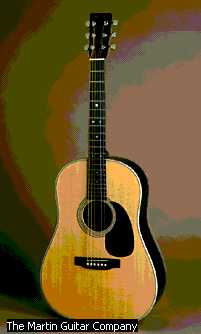
|
The guitar is a stringed
instrument related to the lute, which was a fretted
stringed instrument popular from the fifteenth through
the seventeenth century. The lute was used as both a solo
instrument as well as an accompaniment to singers, much
as the guitar is today. The Moors originally brought the
guitar to Spain in the thirteenth century, and its
development in that country eventually lofted it to
status as the national instrument. In the sixteenth
century, it was a five-stringed instrument, while today
it is a six-stringed instrument, although there are also
twelve-stringed versions. The guitar today is used in
countless settings, such as classical music, as well as
an accompaniment instrument in folk songs, Irish tunes,
and as a featured instrument in American bluegrass music.
|
|
The mandolin first appeared in Italy
at the beginning of the eighteenth century, and like the guitar, was
derived from the lute. The mandolin has four pairs of strings which
are tuned the same as the violin or fiddle. The original instrument
had a gourd-like pear-shaped body, and were used in classical
compositions by such composers as Beethoven and Mozart. By the
twentieth century, mandolins were being used in folk music, and
eventually became one of the core bluegrass instruments. Modern
mandolins have a flat body like a guitar. Interestingly, the mandolin
family includes four different sizes, corresponding to the four
different sizes of instruments in the violin family. They are even
played together in mandolin orchestras.
|
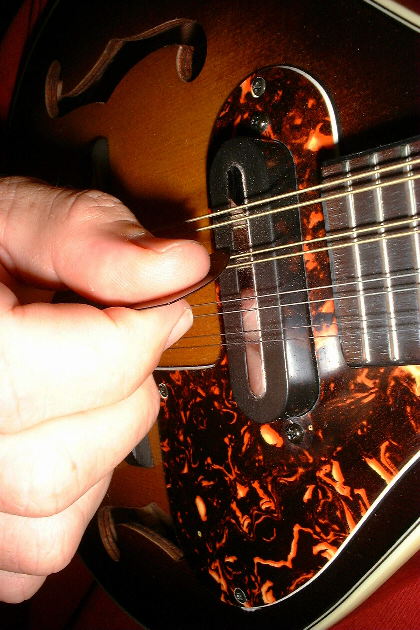
|
|
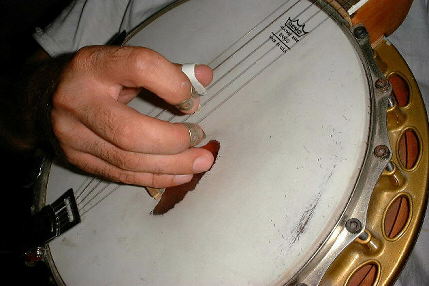
|
The origin of the banjo
is somewhat obscure, but it apparently derived from West
African instruments, which probably descended from an
Arabian instrument known as the rebec, which was composed
of a hollowed gourd covered by animal skin, and a neck
with three strings. African slaves brought the instrument
to the United States, and by the end of the eighteenth
century, the "banjar" was an instrument with
four strings. The four-string banjo is still used today
in Dixieland music and as accompaniment in Irish tunes. In 1831, an American by the name of Joel Walker Sweeney
added a fifth string, and the five-string banjo became an
important part of American bluegrass music in the 1930s. Today, to the chagrin of many four-string players, the
five-string banjo has found a place in Irish music.
|
|
The fiddle is the exact same
instrument as a violin, but it is called a fiddle when
played in certain types of music, such as Irish jigs and reels, and
American bluegrass. The violin is descended from the viol family, and
first appeared in the seventeenth century. It was developed and
perfected in Italy, and soon became an orchestral solo instrument.
Because of its range and ability to project its sound, it also became
popular as a lead instrument in folk and dance tunes in Ireland. When
the Irish came to America, they brought the instrument with them, and it
soon became an important part of American folk music. When bluegrass
developed in the mid-twentieth century, the fiddle was one of the
principal instruments.
|
PHOTO
UNAVAILABLE
|
PHOTO
UNAVAILABLE
|
The bodhrán, pronounced
" 'bow-run, " is a drum made by stretching lamb
skin over a round wooden frame. It is typically eighteen
inches in diameter, and may be played with either the
hand or a two-ended wooden beater. The pitch is changed
by beating on different areas of the head, while the
other hand changes the tension of the head by various
hand placements. The bodhán is used to keep time in
Irish and Celtic dance music.
|
|
The tin whistle is descended from
perhaps the oldest type of musical instrument: a hollowed reed with
finger holes used to change the pitch. A typical tin whistle has
six finger holes and can play several octaves when the player alters
the force with which he blows. The tin whistle is generally used
as a melody instrument, and can be heard playing the lead on jigs and
reels.
|

|
|
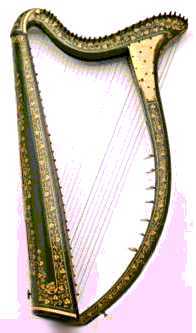
|
There are three different styles of
Irish harp: bow (arched), angle, and the frame harp, which is
pictured at left. All harps consist of a neck, from which the
strings originate, and a sound box, which amplifies the sound caused
by vibrations of the strings. Additionally, there are levers,
called digitals, which are used to alter the pitch of the strings,
allowing the harpist to play in different keys.
|
|
The piano accordion is an instrument
with a piano-style keyboard for the right hand, and bass note buttons
on the left hand. Sound is made by expanding and contracting the
entire body of the instrument, which acts as a bellows. The air
is forced past different reeds as the keys are depressed, creating
different notes. The piano accordion is traditionally used in
German polka bands, but has found its way into many other types of
music, such as traditional Irish dance tunes.
|
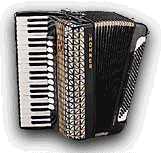
|
|
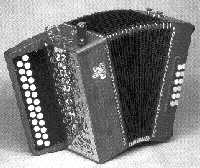
|
Much like the piano accordion, the
button accordion is played with a bellows action and air is forced
past various reeds. Unlike the piano accordion, however, the
button accordion's keyboard consists of buttons rather than
piano-style keys, hence its name. It has been used for many
years to play traditional Irish dance tunes.
|
|
The concertina is much smaller than
the other accordion types, but also consists of a bellows body and
various reeds. The notes are played by depressing small buttons
with alternating hands. The concertina, alternatively known as a
"squeezebox," is used to play traditional Irish dance tunes.
|
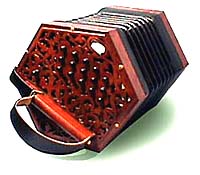
|
PHOTO
UNAVAILABLE
|
The origin of the bagpipes dates back
to the Roman Empire and western Asia in the first century, when they
were shepherd's instruments with single-reed cane pipes, usually
paired with one pipe for the melody and the other as a constant
background pitch (drone). As the pipes migrated westward through
Europe, various changes were made. Drones were added and the
single reed was replaced with a double reed. Bagpipes closely
resembling today's Scottish Highland bagpipes first appeared at the
beginning of the fifteenth century. Today, these pipes are
composed of a mouthpiece to keep the bag inflated, with pressure
sustained by pressing the bag between the arm and the side of the
body, a chanter with finger holes and a double reed, and three drone
pipes which give the constant background sound.
|
|
The uillean pipes are also known as
the Irish union pipes. Derived from the Scottish Highland bagpipes,
they are generally smaller in size. The most significant difference is
the way in which the constant flow of air is maintained through the
pipes. Instead of a mouthpiece into which a player must blow, the
uillean pipes utilize a unique pump, controlled by the elbow moving
inward and outward from the side of the player. This action allows the
player to play the pipes without involved his own lungs in any way.
|

|
PHOTO
UNAVAILABLE
|
The bass is usually constructed using
the first four string of the guitar, and as such, might be considered a
descendent of the guitar. However, the guitar's strings are more
likely based on the bass, since the electric bass and bass guitar we see
in bands today is tuned exactly the same as the bass violin seen in
symphony orchestras. Either way, it is a low-sounding instrument,
and usually played in a regular but rhythmic fashion for the purpose of
keeping time. In music such as rock, folk, jazz and bluegrass, it
is considered one of the two primary rhythm instruments, together with
percussion.
|